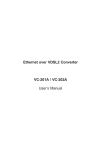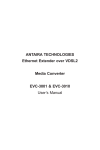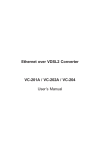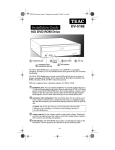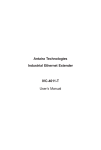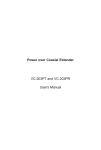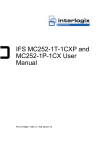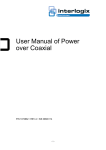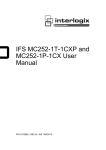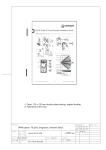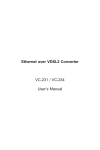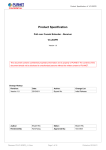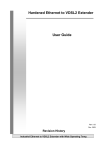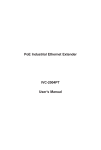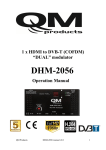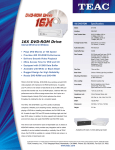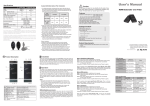Download IFS MCR200-1T/1CX User Manual
Transcript
IFS MCR200-1T/1CX User Manual P/N 1076520 • REV A • ISS 30APR12 Copyright Trademarks and patents Manufacturer EU Version Certification FCC compliance Canada ACMA compliance © 2012 UTC Fire & Security Company. All rights reserved. Interlogix, IFS MCR200-1T/1CX, the IFS Brand and logo are trademarks of UTC Fire & Security. Other trade names used in this document may be trademarks or registered trademarks of the manufacturers or vendors of the respective products. UTC Fire & Security Americas Corporation, Inc. 2955 Red Hill Avenue, Costa Mesa, CA 92626-5923, USA Authorized EU manufacturing representative: UTC Fire & Security B.V. Kelvinstraat 7, 6003 DH Weert, Netherlands This document applies to IFS MCR200-1T/1CX version 1.0. N4131 Class A: This equipment has been tested and found to comply with the limits for a Class A digital device, pursuant to part 15 of the FCC Rules. These limits are designed to provide reasonable protection against harmful interference when the equipment is operated in a commercial environment. This equipment generates, uses, and can radiate radio frequency energy and, if not installed and used in accordance with the instruction manual, may cause harmful interference to radio communications. Operation of this equipment in a residential area is likely to cause harmful interference in which case the user will be required to correct the interference at his own expense. This Class A digital apparatus complies with Canadian ICES-003. Cet appareil numérique de la classe A est conforme à la norme NMB-003 du Canada. Notice! This is a Class A product. In a domestic environment this product may cause radio interference in which case the user may be required to take adequate measures. European Union directives 2004/108/EC (EMC directive): Hereby, UTC Fire & Security declares that this device is in compliance with the essential requirements and other relevant provisions of Directive 2004/108/EC 2002/96/EC (WEEE directive): Products marked with this symbol cannot be disposed of as unsorted municipal waste in the European Union. For proper recycling, return this product to your local supplier upon the purchase of equivalent new equipment, or dispose of it at designated collection points. For more information see: www.recyclethis.info. Contact information Customer support www.utcfireandsecurity.com or www.interlogix.com www.interlogix.com/customer-support Contents Overview 1 Package Contents 1 Ethernet over VDSL2 Bridge Description 1 Product Features 3 Hardware Description 4 MCR200-1T/1CX 4 Front Panel 4 LED Indicators 5 Rear Panel 5 Mode DIP Switch 6 CO/CPE 6 Fast and Interleave mode 7 Band Plan 7 Target SNR (Signal Noise Ratio) Margin 7 DC Power Jack 8 Installation 9 Installing the MCR200-1T/1CX 9 MCR200-1T/1CX LAN to LAN connection 9 Connecting the MCR200-1T/1CX 10 Chassis Installation and Rack Mounting 11 Power Information 13 Troubleshooting 14 FAQ 15 Specifications 17 Contacting Technical Support 19 IFS MCR200-1T/1CX User Manual i Overview Package Contents Check the contents of your package for following parts: • MCR200-1T/1CX x1 • User’s Manual x1 If any of the items in the package are damaged or missing, please contact your distributor or IFS sales rep. If possible, retain the original carton and packaging material in case of need to return the product for repair/replacement. Ethernet over VDSL2 Bridge Description The IFS state-of-the-art Ethernet-over-VDSL2 products are based on two core networking technologies: Ethernet and VDSL2 (Very-high-data-rate Digital Subscriber Line 2). This technology offers the absolute fastest possible data transmission speeds over existing lines or coaxial cables without the need for rewiring. The IFS MCR200-1T/1CX has a switching architecture with RJ-45 10/100Mbps Ethernet port and one asymmetric or symmetric Ethernet over VDSL port (Asymmetric refers to different upstream and downstream rates while symmetric refers to similar rates.) – which is a BNC Connector. The MCR200-1T/1CX can be a data transceiver capable of operating as a Central Office (CO) or Customer Premises Equipment (CPE) mode via a DIP switch. The MCR2001T/1CX asymmetric performance is up to 100/65Mbps at 200m and up to 25/5Mbps for 3km. The MCR200-1T/1CX symmetric performance is up to 100/100Mbps at 200m and up to 17/13Mbps for 3km. IFS MCR200-1T/1CX User Manual 1 This capability is ideal for use as an Ethernet extender for your existing Ethernet network. The MCR200-1T/1CX Converter provides a cost-effective and efficient analog migration to Long Reach Ethernet (LRE) networks. The cable specifications of the connection are listed as follows: • • • 10Base-T, Category 3, 4 or 5 UTP 100Base-TX, Category 5, 5e or 6 UTP Ethernet over VDSL2, Coaxial cable (50 or 75 ohm) The following illustrations are typical application diagrams for the MCR200-1T/1CX. Note: A Slave device (CPE) must connect to a Master device (CO) through 50 or 75 ohm coaxial cable. It does not allow such connections from Master to Master or Slave to Slave. 2 IFS MCR200-1T/1CX User Manual Product Features The MCR200-1T/1CX Ethernet over Coax Converter provides the following key features: • Cost-effective VDSL2 CO/CPE bridge solution • One unit design, CO/CPE selectable via DIP Switch • Defines Asymmetric (Band Plan 998) and Symmetric band plans for the transmission of Upstream and Downstream signals • Complies with IEEE 802.3, IEEE 802.3u and IEEE 802.3x standards • DMT (Discrete Multi-Tone) line coding • Half Duplex Back Pressure and IEEE 802.3x Full Duplex Pause Frame Flow Control • Support up to 1536 bytes packet size, 802.1Q VLAN tag transparent • VDSL2 Stand-Alone transceiver for simple bridge modem application • Selectable Target Band Plan and Target SNR Margin • LED indicators for network diagnostics IFS MCR200-1T/1CX User Manual 3 Hardware Description MCR200-1T/1CX The MCR200-1T/1CX provides 1 BNC connector and supports 50 or 75 ohm cable with distances of up to 3.0km. The MCR200-1T/1CX provides 1 RJ-45 port. It will distinguish the speed of the incoming connection automatically. This section describes the hardware features of the MCR2001T/1CX. Front panel illustrations in this chapter describe the unit LED indicators. Before connecting any network device, we recommend you read this chapter carefully. Front Panel The front panel of the MCR200-1T/1CX provides LEDs for interface monitoring as shown in Figure 1 and following table. Figure 1: MCR200-1T/1CX Front Panel 4 IFS MCR200-1T/1CX User Manual LED Indicators System LED Color PWR Green Function On Off Power ON Power OFF Function On Fast Blinking Indicates that the VDSL link is established. Indicates that the VDSL link is at training status (about 10 seconds). VDSL LED LNK/ACT Color Green Slow Blinking CO Green On CPE Green On Indicates that the VDSL link is at idle status. Indicates the VDSL Bridge is running at CO mode. Indicates the VDSL Bridge is running at CPE mode. 10/100Base-TX Port LED LNK/ACT Color Green Function On Blinking Off 100 On Green Off Indicates that the port link is On. Indicates that the Converter is actively sending or receiving data over that port. Indicates that the port link is Off. Indicates that the port is operating at 100Mbps. Indicates that the port is off or operating at 10Mbps. Rear Panel The units’ rear panel provides a simple interface for monitoring the MCR200-1T/1CX. IFS MCR200-1T/1CX User Manual 5 Figure 2: Rear Panel Mode DIP Switch The MCR200-1T/1CX provides 4 selective transmission modes. By switching the transmission modes, you can obtain the best transmission mode to suit your cable quality or distance of connectivity. The following is a summary table of transmission settings, bandwidth and distance extensibility tested for AWG 24 (0.5mm) twisted-pair without noise and cross talk. DIP-1 DIP-2 DIP-3 DIP-4 Mode Channel Band Plan SNR OFF CO Interleave Symm 9dB ON (default) CPE Fast Asymm 6dB CO/CPE CO (Central Office) – the Master device mode, usually the CO device will be located at the data center of an ISP or enterprise to link to the backbone. For security surveillance applications, the CO setting should be selected for use at the IP camera location to allow for maximum bandwidth utilization of video streaming. CPE (Customer Premises Equipment) – the Slave device mode, usually the CPE device will be located at branch office, 6 IFS MCR200-1T/1CX User Manual home or remote side as the long reach data receiver. The CPE can be connected to a PC, IP Camera or Wireless Access Point network devices. However, for high-end security surveillance applications, the CPE setting should be selected for use at the head-end/NVR location. Note: When the MCR200-1T/1CX operates in the CPE mode, the DIP switches 2, 3, and 4 settings are non-functional. Fast and Interleave mode Fast mode guarantees a minimum end to end latency–less than 1 ms. Interleaved mode provides impulse noises protection with a duration less than 250 µs. Interleaved mode has a maximum end to end latency of 10m sec. Band Plan The user can switch the Band Plan either Symmetric or Asymmetric by their own. While the Symmetric Band Plan gives better upstream performance, the Asymmetric Plan gives better downstream performance. Refer to the table on the previous page. Target SNR (Signal Noise Ratio) Margin When fixed SNR margin is selected, the system will maintain the SNR margin at 9 dB across the entire usable loop length. Note: The default for the DIP switch settings is "ON" for all four switches, which sets the CPE mode. For selecting "CO" mode, please adjust the DIP 1 switch to "OFF". Please power off the MCR200-1T/1CX before making any transmission mode adjustments. IFS MCR200-1T/1CX User Manual 7 DC Power Jack The MCR200-1T/1CX requires 5 VDC power input (Sold Separately). If you have problems related to the power connection, please contact your local sales representative. Note: This device requires power to operate. For continuous functionality of the device, using an UPS (Uninterrupted Power Supply) is recommended to prevent data loss or network downtime. For additional protection against unregulated voltage or current surges, you may also want to consider surge suppression as part of your installation. 8 IFS MCR200-1T/1CX User Manual Installation Installing the MCR200-1T/1CX The MCR200-1T/1CX does not require any software configuration. Users can immediately use any feature of this product simply by attaching the cables and power plug. Based on the quality of the coaxial cable, the maximum distance of one connection is 3.0 km (9842 ft.) with 50 or 75 ohm coaxial cable. Changes in the cable quality would affect the maximum distance of a connection. MCR200-1T/1CX LAN to LAN connection Two sets of the MCR200-1T/1CX should be used to link two local Area networks that are located at different locations. Through a normal coaxial cable, the devices can be set up as a 100/65Mbps asymmetric backbone, but one MCR2001T/1CX must be selected as a Master (CO mode) and the other one as a Slave (CPE mode). Figure 3: MCR200-1T/1CX LAN to LAN connection IFS MCR200-1T/1CX User Manual 9 Connecting the MCR200-1T/1CX Connecting to a Standalone IP device Refer to the following procedures to setup the MCR2001T/1CX to a standalone PC. 1. Set the MCR200-1T/1CX to be CO or CPE mode from the DIP switch at the rear panel. 2. Turn power on the MCR200-1T/1CX by connecting its power source. 3. The power LED will illuminate. 4. Connect the coaxial cable from another MCR200-1T/1CX to the BNC port of the MCR200-1T/1CX. 5. The LNK LED will blink. 6. Connect the Ethernet port to an Ethernet device via regular Cat. 5, 5e, or 6 cables. Figure 4: Connecting Standalone IP devices Connecting Multiple Ethernet Devices to an Ethernet LAN Refer to the following procedures to setup the MCR2001T/1CX to an Ethernet LAN. 1. Set the MCR200-1T/1CX to CO or CPE mode by using the DIP switch at the rear panel. 10 IFS MCR200-1T/1CX User Manual 2. Turn the power on the MCR200-1T/1CX by connecting its power source. 3. The power LED will illuminate. 4. Connect the coaxial cable from another MCR200-1T/1CX to the BNC port of the MCR200-1T/1CX. 5. The LNK LED will illuminate. 6. Connect the Ethernet port to an Ethernet Switch (or Broadband Router) via regular Cat. 5, 5e, or 6 cables. Figure 5: Connecting Multiple PCs to an Ethernet LAN Note: Please refer to your Ethernet device User’s Manual for the device’s set up information. Chassis Installation and Rack Mounting To install the MCR200-1T/1CX into the MCR-R15 media converter rack, follow the instructions described below. 1. Place your MCR200-1T/1CX on a hard flat surface, with the front panel facing you. 2. Carefully slide in the module until it is fully and firmly fitted into the slot of the MCR-R15 chassis. IFS MCR200-1T/1CX User Manual 11 Figure 6: Insert a MCR200-1T/1CX into an available slot of the MCR-R15 3. Attach a rack-mount bracket to each side of the MCR-R15 Chassis with screws supplied with the rack. 4. After the brackets are attached to the MCR-R15 Chassis, use suitable screws to securely attach the brackets to the EIA 19” rack. 5. Proceed with the steps 4 and steps 5 of the Stand-alone Installation on page 11 to connect the network cabling and supply power to your MCR-R15 Chassis. Note: It is recommended to use the screws supplied with the mounting brackets. Otherwise, it may cause damage on the parts if wrong screws are used to install the rack. 12 IFS MCR200-1T/1CX User Manual Power Information The power input of MCR200-1T/1CX is a 2.5mm type in the central post and requires +5VDC power input. It will work with the supported power supply, as well as the MCR-R15 media converter rack chassis. If you need assistance regarding the correct power supply, please contact your local sales representative. 2.5mm DC Receptacle 2.5mm +5V for each slot The MCR-R-15 DC outputs are a 2.5mm type that are designed to power the MCR family of media converters. Do not install any unit that is not supported by this rack, as this may cause damages on media converter and the rack backplane connectors. IFS MCR200-1T/1CX User Manual 13 Troubleshooting SYMPTOM: VDSL LNK LED does not light after the cable is connected to the VDSL port. CHECKPOINT: • Verify that the length of the cable connected between two MCR200-1T/1CX units are not more than 3 km. Please also try to adjust the DIP switch of MCR200-1T/1CX to another SNR mode. • Please note you must use one MCR200-1T/1CX with CO mode and the other MCR200-1T/1CX with CPE mode, when connecting them together. SYMPTOM: TP LED does not light after a cable is connected to the port. CHECKPOINT: • Verify that you are using either Cat.5, 5e, or 6 cables with an RJ-45 connector to connect to the port. • If your device (i.e. LAN card) supports Auto-Negotiation, try to set it to a fixed speed manually. • Make sure that both converter and the connected devices are turned on. • Make sure that all cables are properly plugged in to the correct ports. • Make sure that the cable is not bad. • Make sure that the power adapters are functional for each device. 14 IFS MCR200-1T/1CX User Manual FAQ Q1: What is the voltage and current rating to power MCR2001T/1CX media converter? A1: 5 VDC, 2A Q2: What is VDSL2? A2: VDSL2 (Very High-Bit-Rate Digital Subscriber Line 2), G.993.2 is the newest and most advanced standard of xDSL broadband wire line communications. Designed to support the wide deployment of Triple Play services such as voice, data, high definition television (HDTV) and interactive gaming, VDSL2 enable operators and carrier to gradually, flexibly, and cost efficiently upgrade exiting xDSLinfrastructure. Q3: What is the recommended maximum distance between MCR200-1T/1CX media converters? A3: 3 kilometers. Q4: What is the maximum data rate for MCR200-1T/1CX? A4: 100Mbps/65Mbps (downstream/upstream) at 200 meters. Q7: What is SNR and what’s its effect? A7: In analog and digital communications, Signal-to-Noise Ratio (SNR) is a measure of signal strength relative to background noise. The ratio is usually measured in decibels (dB). In digital communications, the SNR will probably cause a reduction in data speed because of frequent errors that require the source (transmitting) computer or terminal to resend some IFS MCR200-1T/1CX User Manual 15 packets of data. SNR measures the quality of a transmission channel over a network channel. The greater the ratio, the easier it is to identify and subsequently isolate and eliminate the source of noise. Generally speaking, the higher SNR value gets better line quality, but lower performance. Q8: What is band plan and what’s the effect? A8: VDSL2 defines multiple band plans and configuration modes (profiles) to allow asymmetric and symmetric services in the same binder (by designated frequency bands) for the transmission of upstream and downstream signals. The user has the ability to select a fixed band plan. Symmetric band plan provides better downstream performance while Asymmetric band plan provides better upstream performance. 16 IFS MCR200-1T/1CX User Manual Specifications Product MCR200-1T/1CX Hardware Specifications 10/100 1 x RJ-45, Auto-negotiation Auto-MDI/MDI-X Base-TX Ports 1 x BNC, VDSL female connector DIP Switch 4 position DIP switch • CO / CPE mode select • Selectable fast and interleaved mode Functionality • Selectable target Band Plan • Selectable target SNR mode • VDSL-DMT - ITU-T G.993.1 VDSL Encoding - ITU-T G.997.1 - ITU-T G.993.2 VDSL2 (Profile 17a Support) One Power LED Indicators 3 for RJ-11/VDSL2 2 for RJ-45 10/100Base-TX port Ethernet • 10Base-T: 2-pair UTP Cat.3,4,5 up to 100m (328ft) • 100Base-TX: 2-pair UTP Cat.5, 5e, 6 up to 100m (328ft) VDSL 50 ohm, RG58A/U, RG58C/U, RG58/U or 75 ohm, RG6 (Distance 3.0km) Cabling IFS MCR200-1T/1CX User Manual 17 Asymmetric Mode Performance* (Down Stream / Up Stream) Power Requirement Operating Temperature Storage Temperature Operating Humidity Storage Humidity Standard Conformance Regulation Compliance Standards Compliance 200m -> 100/65Mbps 400m -> 100/64Mbps 600m -> 100/59Mbps 800m -> 100/53Mbps 1000m -> 94/44Mbps 1200m -> 84/36Mbps 1400m -> 74/28Mbps 1600m -> 66/19Mbps 1800m -> 60/14Mbps 2000m -> 44/15Mbps 2200m->35/12Mbps 2400m->32/10Mbps 2600m->29/8Mbps 2800m->27/6Mbps 3000m->25/5Mbps Symmetric Mode 200m ->100/100Mbps 400m -> 97/100Mbps 600m -> 86/91Mbps 800m -> 79/80Mbps 1000m -> 69/66Mbps 1200m -> 60/52Mbps 1400m -> 51/41Mbps 1600m -> 45/36Mbps 1800m -> 40/29Mbps 2000m -> 27/26Mbps 2200m->23/24Mbps 2400m->22/21Mbps 2600m->20/18Mbps 2800m->18/15Mbps 3000m->17/13Mbps 5V DC, 2A 0~50ºC -10~70ºC 10% to 90%, relative humidity, non-condensing 10% to 90%, relative humidity, non-condensing FCC Part 15 Class A, CE IEEE 802.3 10Base-T IEEE 802.3u 100Base-TX IEEE 802.3x Full Duplex Pause frame Flow Control ITU-T 。 G.997.1 。 G.993.1 VDSL 。 G.993.2 VDSL2 (Profile 17a) * The actual data rate will vary on the quality of the cable and environmental factors. 18 IFS MCR200-1T/1CX User Manual Contacting Technical Support Contact technical support if you encounter any difficulties during this installation. Please make sure you have the requested diagnostic or log files ready before you contact us by phone or go to www.interlogix.com/customer-support. Technical Support Europe, Middle East and Africa W Select Contact Us at www.utcfssecurityproducts.eu North America T +1 855.286.8889 E [email protected] Australia E [email protected] IFS MCR200-1T/1CX User Manual 19

























